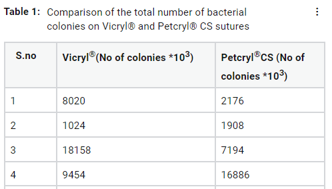Abstract
Surgical Site Infections (SSIs) are one of the most common complications of any intervention in the maxillofacial region. Most of the times sutures used for wound approximation act as a nidus of bacterial accumulation and subsequent infection due to the presence of scores of microbes in and around the oral cavity. This has been attributed to the wicking action associated with braided sutures. Various methods to prevent surgical site infections are reported in literature, the most recent being use of antibacterial coated sutures. Sutures are either coated with triclosan or chlorhexidine or a combination of anti-microbial agents and fatty acids. These sutures are known to have a significant role in the prevention of SSIs elsewhere in the body, but the role in oral cavity remains questionable. This study aims to establish the role of chlorhexidine coated sutures in the prevention of surgical site infections if any. Chlorhexidine-coated and uncoated suture materials were used in 17 patients undergoing third molar extractions. Seven days post-operatively the sutures were removed, and bacteria were isolated. Following which colony-forming units (CFU/ml) were counted. Concerning the total number of oral pathogens, that adhered to suture material, no reduction was demonstrated for Chlorhexidine coated sutures. The use of chlorhexidine-coated suture material offers no advantage in intraoral surgery.
Full text article
Authors

This work is licensed under a Creative Commons Attribution-NonCommercial-NoDerivatives 4.0 International License.

